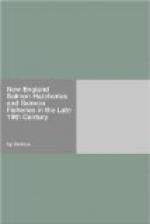This inclosure was a complete failure. The salmon placed therein were after a day or two attacked by a parasitic fungoid growth on the skin, and in a few days died. Out of 59 impounded not one escaped the disease and only those speedily removed to other waters recovered. Several, removed in a very sickly condition to the lake supplying the brook, recovered completely, from which it is safe to infer that the cause of the trouble did not lie in the lake water.
Of the spring water I have some suspicions, and should not dare to inclose salmon in it again.
No. 2. After the failure of the above experiment an inclosure was made in the edge of an ordinary lake by stretching a stout net on stakes. This water was brown in color, and objects 4 feet beneath the surface were invisible. The bottom was gravelly and devoid of vegetation.
The depth was 7 and one half feet in early summer, and about 4 feet after the drought of August and September. The area inclosed was about 25 square rods in June, and perhaps half as much at the end of summer. This inclosure was entirely successful, very few salmon dying in it except those that had been attacked by disease before their introduction, and all the survivors were found to be in first-rate condition in November. This site was not afterwards occupied, because it was inconveniently located, and was exposed to the full force of violent winds sweeping across the lake, and therefore unsafe.
No. 3. The inclosure in use for the confinement of the stock of breeding fish for the four years from 1872 to 1875, inclusive, was made by running a barrier across a narrow arm of a small lake (mentioned in official reports as “Spofford’s Pond”) near Bucksport village. This body of water, about 60 acres in area in the summer, receives the drainage of not more than 5 square miles of territory through several small brooks, that are reduced to dry beds by an ordinary drought. About a quarter of the shores are marshy and the rest stony. The water is highly colored by peaty matters in solution, and all objects are invisible at a depth of 2 feet: The bottom is composed mostly of a fine brown peaty mud of unknown depth. Aquatic vegetation of the genera, Nuphar, Nymphaea, Bragenia, Potamogeton, &c., is abundant. The water is nowhere more than 16 feet deep in the spring, and 11 feet in midsummer. The portion inclosed is 2 feet shoaler.
The inclosure occupied sometimes 8 or 10 acres, and sometimes less. The barrier was from 400 to 600 feet long, and was formed the first year of brush; the second and third years of stake-nets, weighted down at the bottom with chains; and the fourth year of wooden racks, 4 feet wide and long enough to reach the bottom, which were pushed down side by side. The brush was unsatisfactory. There were holes in it by which the fish escaped. A single net would not retain its strength through a whole season, the bottom rotting away and letting the fish out, unless before the autumn was far advanced its position were reversed, the stronger part that had been above water being placed now at the bottom. This method was therefore rather expensive and not perfectly secure. The wooden racks were costly and heavy to handle, but quite secure.




